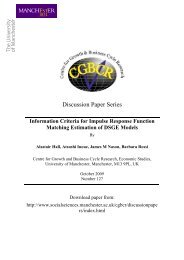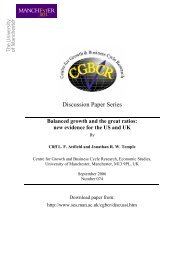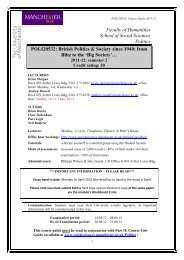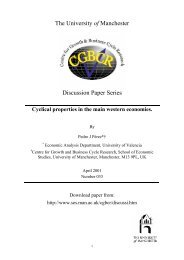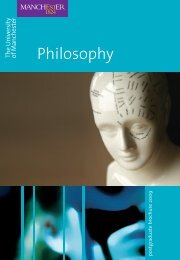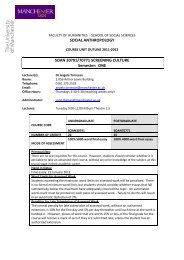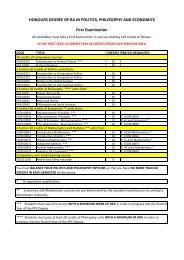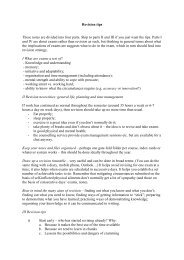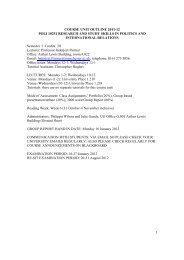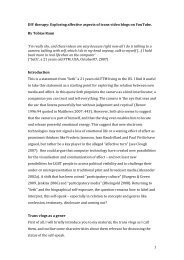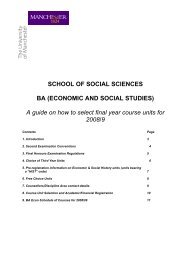CHNN 22, Spring 2008 - School of Social Sciences
CHNN 22, Spring 2008 - School of Social Sciences
CHNN 22, Spring 2008 - School of Social Sciences
You also want an ePaper? Increase the reach of your titles
YUMPU automatically turns print PDFs into web optimized ePapers that Google loves.
Yorkshire and Wales, less ‘traditional’ areas where membership decline had been lower came to<br />
carry a greater weight within the organisation. But the picture was not one <strong>of</strong> universal decline;<br />
some areas saw substantial new growth in membership and branches. And in elections the party<br />
achieved some modest success in some <strong>of</strong> its strongholds.<br />
Though the ILP became more consciously orientated towards the trade union movement following<br />
disaffiliation its impact was patchy and, overall, modest. It should have done better with women.<br />
One <strong>of</strong> the features <strong>of</strong> the early ILP back in the 1890s and 1900s had been that it was far less<br />
‘masculine’ in tone than its rival socialist organisations, notably the SDF. Women had played a<br />
relatively large part in its organisation at all levels and in a variety <strong>of</strong> roles, with, for example<br />
Katherine Bruce Glasier taking over the editorship <strong>of</strong> the Labour Leader for several key years<br />
either side <strong>of</strong> the end <strong>of</strong> the Great War. In the post-disaffiliation period there were only three<br />
women members <strong>of</strong> the NAC. Two <strong>of</strong> them, Dorothy Jewson and Jennie Lee, lasted only until 1934<br />
and 1935 respectively, leaving Kate Spurell as the sole female member. Separate representation <strong>of</strong><br />
women within the party, already declining in previous years, was brought to an end – with the<br />
support <strong>of</strong> the ‘revolutionary’ element – soon after the breach with Labour.<br />
Another area where the impact <strong>of</strong> this wing <strong>of</strong> the membership can be seen concerned the<br />
organisation <strong>of</strong> the party. Since its inception, the ruling body – between national conferences – had<br />
been the National Administrative Council. The name was deliberately chosen to suggest that this<br />
body would not behave in the authoritarian way attributed to many, if not all, executive<br />
committees. At a time when such issues as whether the ILP should have a ‘president’ caused much<br />
debate and when the Clarion, weekly rival <strong>of</strong> Labour Leader, would inevitably leap on any<br />
pretensions to ‘leadership’ among the notables <strong>of</strong> the party and was prone to spot the slightest sign<br />
<strong>of</strong> incipient bureaucracy this was very much in accord with the times.<br />
But in the 1930s sterner attitudes came to the fore. In 1934, against the inevitable objection <strong>of</strong><br />
many, notably Jowett, the ILP adopted its own version <strong>of</strong> ‘democratic centralism’ involving the<br />
creation not only <strong>of</strong> an executive committee but also the rather sinister sounding Inner Executive.<br />
The latter was supposed to enable the party to function ‘underground’ should the ILP be made<br />
illegal; but by 1935 it consisted <strong>of</strong> three MPs – James Maxton, Campbell Stephen, and John<br />
McGovern – who met in a committee room <strong>of</strong> the House <strong>of</strong> Commons, rather than the Doge’s<br />
Palace as the name might have led one to anticipate. It became a controversial force, accused <strong>of</strong><br />
dictatorship, especially in relation to the ‘Abyssinian crisis’. I would have welcomed more about the<br />
arguments on both sides <strong>of</strong> the ‘democratic centralism’ debate and the subsequent criticisms and<br />
defences <strong>of</strong> the new structure.<br />
The key chapter <strong>of</strong> the book in explaining ‘the failure <strong>of</strong> a dream’ seems to be ‘Divided We Fall’. It is<br />
always difficult to draw the line between productive critical debate and destructive factionalism<br />
and this was exemplified by what took place in the ILP during the years in question. Apart from<br />
those wishing to remain affiliated to the Labour Party who helped form the <strong>Social</strong>ist League, there<br />
were at least three distinct groupings pulling in very different directions. The Revolutionary Policy<br />
Committee’s notion <strong>of</strong> a ‘revolutionary’ policy did not correspond to the interpretation <strong>of</strong> other<br />
would-be revolutionaries in the party. It stood among other things for closer co-operation with the<br />
communists, nationally and internationally: an approach which seemed to flourish for a couple <strong>of</strong><br />
years and then become untenable after events in Spain, above all in Barcelona, put the two<br />
organisations at loggerheads. Soon after the RPC left en masse to join the CP. In the meantime,<br />
unimpressed by the progress being made by the RPC, the CPGB had infiltrated both the ILP’s youth<br />
movement and the ILP itself. The CP’s central committee set up a Committee for Affiliation to the<br />
Comintern within the ILP. Those who had been ILP members in 1920 and 1921 must have recalled<br />
the attempts <strong>of</strong> the ‘Left-Wing <strong>of</strong> the ILP’ to secure the party’s affiliation to the Third International.<br />
But this time the ILP also attracted the attentions <strong>of</strong> trotskyists in the shape <strong>of</strong> the ‘Marxist Group’.<br />
Moves in these directions were opposed by a ‘Unity Group’ – whose title was not <strong>of</strong> course intended<br />
to be ironic, though much <strong>of</strong> it left to form the Independent <strong>Social</strong>ist Party in 1934. The group was<br />
committed to ‘ethical socialism’. It would have been good if this had been explored more fully,<br />
though Cohen does supply some interesting examples <strong>of</strong> the related social activities <strong>of</strong> the party. To<br />
some extent at least the ILP by the 1930s had become a sort <strong>of</strong> residuary legatee <strong>of</strong> much <strong>of</strong> the preleninist<br />
radical left, including aspects <strong>of</strong> the Clarion movement, the guild socialists, the syndicalists<br />
and perhaps even the old SDF as well as the ILP’s ‘traditional’ features. Its opponents within the<br />
52



